With the USS McCain collision, even Navy tech can't overcome human shortcomings
One mistake can cascade into a disaster in heavy marine traffic, regardless of tech.source: https://arstechnica.com/gadgets/2017/08/with-the-uss-mccain-collision-even-navy-tech-cant-overcome-human-shortcomings/\
SEAN GALLAGHER - 8/25/2017, 8:15 AM
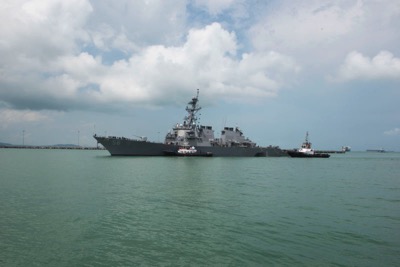
In the darkness of early morning on August 21 [2017], the guided-missile destroyer USS John S. McCain collided with a tanker in the Strait of Malacca off Singapore. Ten sailors are believed to have lost their lives in the McCain collision. When added to the seven who died
The McCain's collision was the fourth this year between a naval vessel and a merchant ship—the third involving a ship of the US Navy's Seventh Fleet. (The other collision involved a Russian intelligence collection ship near the Bosporus Strait in Turkey.) There hasn't been a string of
collisions like this since the 1950s.
Collisions are one of the biggest nightmares of those who go to sea. Cmdr. W.B. Hayer famously posted a brass plaque on the bridge of the destroyer USS Buck misquoting Thucydides: "A collision at sea can ruin your entire day" (this quote later found its way to Navy training posters). But few can look at the photos of Berthing 2 or the captain's stateroom aboard the USS Fitzgerald in the Navy's recent supplemental report on its collision and laugh.
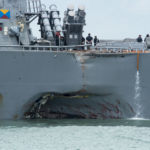
Collisions involving naval vessels, especially those resulting in a loss of life, have been relatively rare over the last two decades. And they usually happen during risky close maneuvering with other military ships. Before this year, the last collision between a US Navy ship and a civilian vessel was in 2004, when the aircraft carrier USS John F. Kennedy ran over a dhow in the Persian Gulf during night air operations. (A dhow is a traditional Arab sailing vessel.) [Correction: as a reader pointed out, the USS Porter (another Arleigh Burke class destroyer) collided with the Very Large Crude Carrier Otowasan in 2012.]
So, why, with radars that can track targets smaller than a meter in size, satellite navigation-aided collision warning systems, and an array of other sensors and systems to provide "situational awareness," are naval ships colliding with anything? That's the question that the Navy is now investigating.
Initial reports from the organization suggest that a "steering casualty"—a loss of control over steering from the bridge—contributed to the McCain's fatal collision. That, and the nature of the ship's steering and navigation system, has led to speculation that the McCain was "hacked" and that perhaps some sort of malicious electronic attack was also involved in the Fitzgerald's collision.
But so far, available evidence suggests something much less sinister—though potentially more threatening to the overall readiness of the service. There was no hacking, no GPS spoofing or jamming, nor any other deliberate enemy electronic attack on the Navy ships involved in this year's accidents. Instead, much more human factors were at work—and some of them are endemic to the Navy's current management culture and operational readiness.
Gibraltar
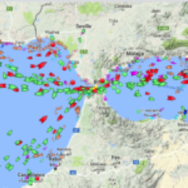
Bosporus and Dardanelles
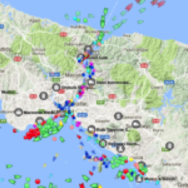
Malacca Strait
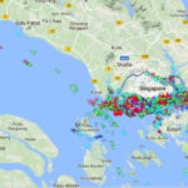
South Korean (Busan)
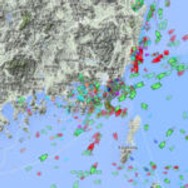
Tokyo Bay
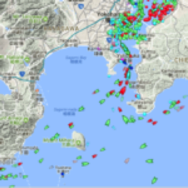
Each of the collisions this year happened under widely different circumstances, though they have one major thing in common: all of them (the Russian collision included) happened in some of the most congested waters in the world. And unlike naval ships, many of the other vessels traveling through those waters have minimal bridge crews, limited communications, and a lot less maneuverability. Even when merchant ships are in the wrong, navigationally speaking, Navy ships generally are in a better position to maneuver out of the way and can't depend on the other ships to follow the rules of the road.
Watch standers aboard modern warships may have more technology to help them, but they still face a daunting task when they enter high-traffic areas as treacherous as the Strait of Gibraltar—or the Strait of Malacca, the approaches to the Bosporus and Dardanelles, and the approaches to Tokyo Bay. In each, hundreds of other vessels may be visible to the naked eye or on the radar scope. The resulting sea of data points can overwhelm even an experienced bridge crew regardless of how good their technology is.
In the investigation into the collision of the Fitzgerald, according to a statement by a Seventh Fleet spokesperson, Navy investigators found that:
The collision was avoidable and both ships demonstrated poor seamanship. Within Fitzgerald, flawed watch stander teamwork and inadequate leadership contributed to the collision that claimed the lives of seven Fitzgerald Sailors, injured three more, and damaged both ships... Several junior officers were relieved of their duties due to poor seamanship and flawed teamwork as bridge and combat information center watch standers. Additional administrative actions were taken against members of both watch teams.
One of the symptoms of that "flawed teamwork" was that the bridge and CIC (Combat Information Center) watch teams had lost their picture of what was going on around them. "Clearly at some point, the bridge team lost situational awareness," Adm. Bill Moran, the deputy chief of naval operations, told reporters on August 17.
I have some personal experience in losing the bubble. In 1987, I was on my first major deployment aboard the USS Iowa and standing one of my first night bridge watches of the deployment. We just happened to be traversing one of the most heavily trafficked stretches of water in the world—the Strait of Gibraltar.
The Iowa had a decidedly low-tech bridge. The helmsman steered the ship from within an 18-inch armored "citadel" at the center of the bridge. There was a single radar repeater on the bridge to track other shipping traffic, and a backlit board marked with grease pencil listed other vessels being tracked visually or by radar, either by name or by a letter designator.
I was trying to keep track of every fishing boat and merchant ship in my head with well over 40 visual contacts bobbing around us as we steamed east. When the captain came onto the bridge and began to interrogate me about what each contact was, I choked about halfway through the report. He took me to the bridge wing to chew me out and kicked me off the watch team for the night. I spent the rest of the watch standing there, face burning with shame.
At least I knew when I had lost the bubble. Collisions happen because watch crews don't realize what they don't know.
With restricted room to maneuver, ships routinely pass close to each other following the International Rules of the Road. Not every ship has the communications tools at the disposal of a naval ship—and even when they do, some don't respond to hails by radio or flashing light. Sensors only work when the people looking at their screens have a handle on what's going on. And often, merchant ships are being steered by "Iron Mike"—their autopilot—with little human attention.
When in a navigation channel, lookouts and bridge crew may be more focused on oncoming traffic than ships entering from one side or the other of the channel simply because they're a more urgent threat—and the relative motion of ships closing from the side may not seem like an immediate threat if there's nothing to draw them back to attention. At night, it may be hard to tell which way merchant ships are headed, despite the navigation lights all vessels are required to have lit. Other lighting—either from the ships themselves or from lights on the shore behind them—can complicate everything.
Even in relatively open seas, bridge crews can lose situational awareness quickly, especially if they're distracted by other tasks or emergencies. When entering a port, there are checklists of preparations being driven by the bridge watch team. And when something goes wrong, the whole picture can get lost quickly.
A loss of steering control (such as on the McCain) or a similar system failure, under the best of cases, triggers an emergency checklist to re-establish some level of control. Usually during operations in restricted channels, there's someone standing by an emergency steering station (called "after steering" because it's usually near the stern of the ship close to the rudder itself). But prior to entering port, there may not be someone standing by there to take over.
The steering failure was likely linked to a failure of the McCain's integrated bridge navigation system (IBNS)—the centralized electronic helm and navigation console. The McCain is equipped with an older version of the system, introduced in the Arleigh Burke class. It's a militarized version of a class of systems that is now common aboard merchant vessels, providing the bridge crew with both control over steering and propulsion and a view of navigational and sensor data. On more recent Navy ships, these systems can be used to reduce the number of people required on the bridge watch team. On the two classes of Littoral Combat Ship, for example, the ship's "conning officer" station is more of a cockpit; the Officer of the Deck actually drives the ship seated with a joystick.
But aboard the Arleigh Burke class ships, the actual driving is still done by enlisted sailors responding to orders from the officers on watch. A loss of steering would not be directly obvious to the bridge watch team officers until they either got a report from the helmsman or noticed themselves that the ship's heading wasn't changing as ordered.
It's not clear if the other parts of the IBNS system, such as the electronic chart and surface radar displays, failed as well. But if the bridge watch team was trying to troubleshoot the problem in the middle of overtaking or crossing the Alnic MC (a Liberian-flagged 600-foot oil and chemical tanker), it may have given them little time to recover situational awareness and ship control before a collision. And if they were over-reliant on the electronic systems to provide that awareness, they may have been blind to what was about to happen.
The same is true of the merchant ship that hit the McCain. Based on the course followed by the ship, several sources Ars has conferred with suggest it's highly likely that the ship was on auto-pilot at the time of the collision, en route to pick up a pilot to bring the ship to an oil-handling terminal or to an anchorage to await unloading. The crew may have not even been paying attention when the McCain–which, based on the point of collision, would have had the right of way—passed in front of the ship.
All the electronic tools in the world won't help when the collision risk is essentially invisible. The Automated Identification System that provides most of the ocean-going ships in the world with some measure of collision avoidance doesn't work too well when it's turned off, nor if the Global Positioning System it depends on for position data is spoofed or jammed or blocked. US Navy ships frequently turn off their AIS transponders to conceal their positions during operations, but sometimes other ships turn theirs off, too—if these ships ever had AIS in the first place.
That's particularly true of fishing boats, which may or may not be fishing in places they're not supposed to. Smaller fishing boats and sailing craft may not be required to carry AIS to identify themselves, depending on the enforcement of UN regulations. And these smaller craft are less likely to be picked up on radar and identified as a threat, especially in heavy seas. The SPY-1 Aegis radar may be able to detect a target the size of a duck in the stratosphere, but it's not particularly helpful in spotting boats bobbing in six to ten foot swells.
In May, the guided missile cruiser USS Lake Champlain was off the coast of Busan, South Korea, as part of the aircraft carrier USS Carl Vinson's task force when it encountered a 65-foot South Korean fishing boat in low visibility. The fishing boat, the 502 Nam Yang, had no working radio, GPS, or AIS, and it failed to respond to horn blasts from the Lake Champlain. Fortunately, when the Nam Yang ran into the Lake Champlain, it only left a small dent and was able to proceed home under its own power.
This, of course, raises some significant concerns about "force protection." What if the Nam Yang had been a North Korean fishing boat loaded with explosives? This isn't a theoretical concern. Two Royal Saudi Navy sailors were killed when a swarm of Houthi suicide boats attacked a Saudi frigate off the coast of Yemen in January. The US Navy has trained to repel small boat swarms, but that training has thus far gone mostly untried. And if you can't spot a 65-foot fishing boat coming at you until it's nearly about to collide, boat defense training really doesn't matter.
The beatings will continue until morale improves
Fatigue and stress can also make bridge crews dangerously less effective. That has become a major issue for the Navy over the past few years, as "operational tempo," lengthened deployments, and fixing things on the fly have made for long hours for watchstanders.
Fatigue and strain may have factored in to the collision of the Russian intelligence ship Liman, which was struck near mid-day in fog by a livestock carrier bound for Jordan with a load of Romanian sheep. Having just returned from operations off Syria, the Liman returned to the Black Sea only to be immediately dispatched to monitor a NATO-Ukraine joint naval exercise called Sea Breeze. The ship, built in the 1970s, carried containers of sensitive electronic warfare and signals collection systems on its aft main deck.
The Bosporus strait had been closed due to poor visibility, so the sheep ship, the Youzarsif H, was holding north of the entrance to the strait. According to the Turkish Coast Guard, the Liman cut across the Youzarsif H's bow and was struck on the starboard side, amidships—the bulbous underwater nose of the sheep carrier breaching the spy ship's hull.
After the fact, the Black Sea Fleet claimed that the Liman was in fact at anchor, and the BSF stated it wanted the Youzarsif H's captain arrested for leaving the scene—despite the fact that the livestock carrier's crew assisted in the rescue of Liman's sailors. But it's more likely that after months at sea on a 40-year-old ship, maintenance issues and crew fatigue coupled with congested shipping lanes, bad weather, and perhaps some shenanigans by the Liman's crew led to an embarrassment for the Black Sea fleet. Gear more sensitive and valuable than the ship itself ended up at the bottom.
But the US Navy has its own particular history of creating fatigue through stress. The Navy's Surface Warfare community has a reputation for "eating its young." A "Zero-Defect" management mentality toward leadership has, despite entreaties from higher in the ranks, been ingrained in the surface Navy's command structure. When something happens, junior officers get burned. There is no learning from mistakes—only punishment for making them.
Couple that with tougher tasks than ever. Over the past decade, as a Government Accountability Office study in 2015 noted, "to meet the increasing demands of combatant commanders for forward presence in recent years, the Navy has extended deployments; increased operational tempos; and shortened, eliminated, or deferred training and maintenance." And to increase the availability of ships for ongoing missions in the Mediterranean and the Western Pacific, the Navy has "home-ported" ships overseas.
But the increased use of these forward deployed ships—which spent twice as much time at sea as similar ships based in the US—has had an impact on the training and maintenance of those ships in particular. In the Seventh Fleet, ships no longer even have a designated period for training. These days some Navy observers suggest the US may have the best equipped fleet in the world, but it no longer has the most skilled sailors driving them.
The result, based on much of the anecdotal data I've collected, is that many good junior officers are leaving the service as soon as their initial obligation ends because of the toxicity of the Navy's leadership culture. That kind of stress, despite the best intentions, can have consequences. And those consequences can create cycles of their own.
In the spring of 1987, off the US East Coast, the USS La Moure County was temporarily under the command of the ship's squadron commander after the captain had been relieved following a collision during an amphibious landing exercise. In the middle of the night while I was on CIC watch, the La Moure County came close to another collision with the Iowa despite a barrage of warnings. The La Moure had already lost her captain, relieved because of another collision a few weeks earlier, and a watch team had been fired. Perhaps the bridge watch that night was fatigued or stressed by other details.
The La Moure must have been a cursed ship. In the fall of 2000, it ran aground off Chile and was found to be unsalvageable. It was sunk during a live fire "Sinkex" off the Chilean Coast in early 2001. The ship's grounding, along with another wave of maritime accidents, resulted in operational pause for the Navy.
That's exactly how the Navy has initially responded to these latest collisions—by implementing a safety-oriented "operational pause." It's essentially a stand-down to review safe operating procedures, and the Navy has frequently used the tactic as a sort of reset button after a string of incidents. There's also an ongoing investigation, ordered by the Navy's top commander, into issues that may have contributed to the accidents, including crew training and certification. The entire command team of the USS Fitzgerald has been fired, and the Navy's leadership has also relieved Vice Adm. Joseph Aucoin, commander of the Navy's Seventh Fleet, which is responsible for the Western Pacific.
Some experts believe that the Navy's reduced size and increased operational tempo have caused the service to defer too much training time, neglecting training in basic seamanship to meet the demands placed on the service. This is particularly true in the Seventh Fleet, where forward-deployed ships like the Fitzgerald and McCain are underway much more often than their counterparts stationed at US bases. The very nature of the places these ships operate puts them at greater risk of collision to begin with. And without proper training and oversight, watchstanders may not be ready to deal with the situations they're put in—with potentially disastrous results.
Hopefully, the Navy will go beyond a simple safety stand-down this time. If this examination of root causes actually does move past the laying of blame for the latest collision, perhaps the Navy can begin to address some of the leadership and cultural issues that are at the root of the service's problems. Having experienced several "pauses" myself during my service, however, I'm not confident that changes will come quickly.
